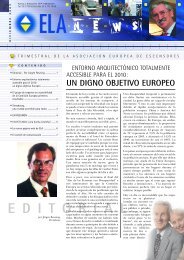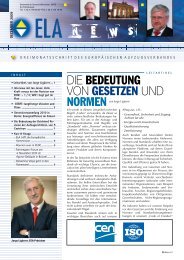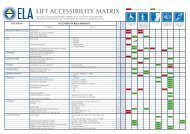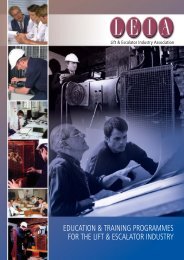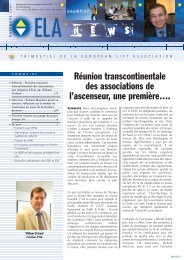WP6-Brochure-E4 brochure - ELA European Lift Association.
WP6-Brochure-E4 brochure - ELA European Lift Association.
WP6-Brochure-E4 brochure - ELA European Lift Association.
You also want an ePaper? Increase the reach of your titles
YUMPU automatically turns print PDFs into web optimized ePapers that Google loves.
When combined with hall call control systems, double‐deck lifts performance is further<br />
improved, allowing buildings to reach a lift performance that would be impracticable with<br />
single‐deck lifts.<br />
Recent developments in intelligent control and safety systems have allowed the use of two<br />
independent cars travelling in the same shaft. This can translate into a significant improvement<br />
in handling capacity. Manufacturers claim that by using such systems 40% more passengers<br />
are transported in a typical four‐shaft group.<br />
3.6 Transmission and Roping<br />
The low and medium speed traction lift market (< 2,5 m/s) is still largely dominated by geared<br />
units. In these lifts, a gearbox is used to reduce the shaft speed and produce the required<br />
torque to start the lift car moving. Gearing allows the use of smaller, less expensive motors.<br />
However, energy is dissipated as heat caused by friction between the gear’s teeth, and<br />
churning losses in the lubricant.<br />
Figure 3‐25. Worm gear<br />
Typically, worm gears have been the prevalent choice for the reduction of speed since they<br />
provide good shock absorption, quiet operation, and high resistance to reversed shaft rotation.<br />
However, their efficiency is relatively low (typically 60% ‐ 70%) and the efficiency in reverse<br />
rotation is significantly lower than in the forward direction. The efficiency of the gear train<br />
depends on the lead angle of the gears and the coefficient of friction of the gear materials. The<br />
efficiency also depends on the operating parameters of the gear train. Usually, smaller<br />
reduction ratios, higher input speeds to the worm, and larger sizes result in higher efficiency.<br />
Helical gears have higher efficiency than worm gears, typically over 98% per stage, and are<br />
being used in some of the more recent lift systems. Since there is less sliding between the<br />
gear’s teeth, they present improved efficiency.<br />
According to information provided by manufacturers, the transmission efficiency of helical<br />
gears is roughly 20 ‐ 30% higher than that of worm gear, thus enhancing the overall<br />
mechanical efficiency of the lift equipment. However, helical gears can be noisier and have<br />
higher initial costs.<br />
37





